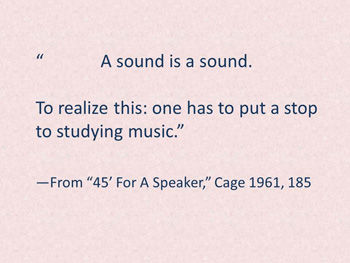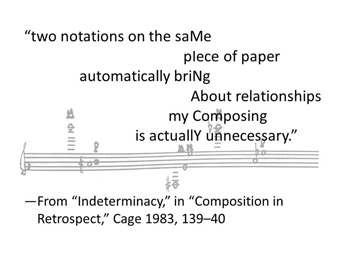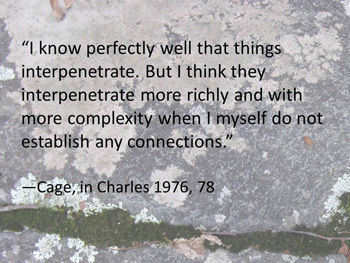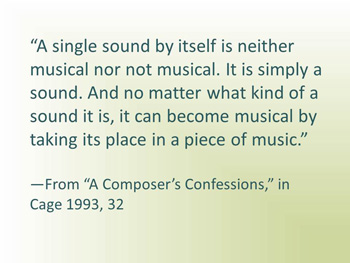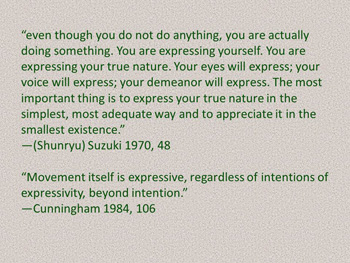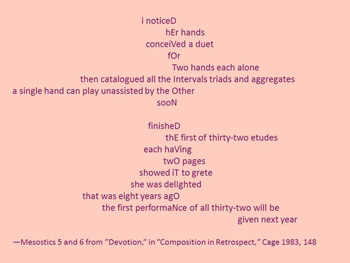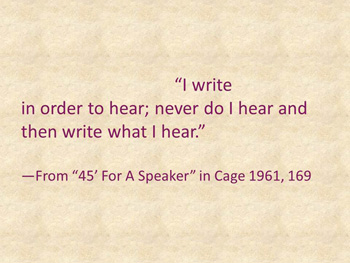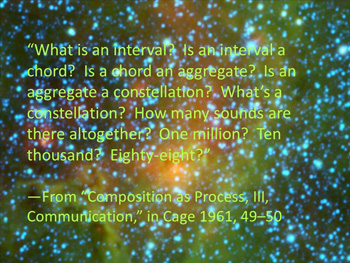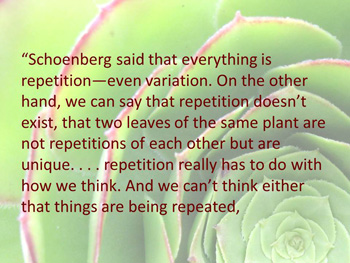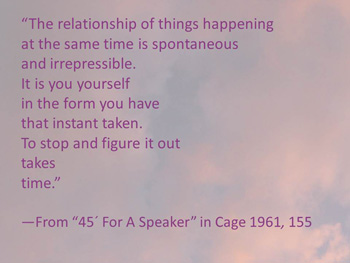Volume 20, Number 2, June 2014
Copyright © 2014 Society for Music Theory
Asking QuestionsDora A. Hanninen
|
[1.1] Analysts of Cage’s music face many challenges. The rigorous use of chance procedures, multifaceted and multimodal nature of Cage’s creative work, indeterminacy of the score in relation to performance, and large scale of some of Cage’s works, all raise basic questions of analytic methodology. But even more fundamental is the need to articulate an ethic of music analysis appropriate for Cage’s music: not how one analyzes, but whether one can, or should, analyze; who analyzes; and why. In this paper I will focus not on methodology but on these broader questions. Intention (especially the asymmetry of intention among composer, performer, and listener), the ecology of musical sound, and the politics, nature, and purpose of music analysis, are all considerations as we develop an ethic of analysis as a non-reductive, transformative activity, a process of inquiry and discovery.
[1.2] A number of the questions one might pose with regard to analysis of Cage’s music arise in relation to his compositional aesthetic of “asking questions” rather than “making choices.” Underlying the great variety in Cage’s work over fifty years, including his music, writings, and visual art, is a determination, consistent with his engagement with Zen Buddhism, to detach ego from the compositional process and minimize the role of his tastes and intentions.(1) So it is there, with Cage’s commitment to creating an art of non-intention, and some of its implications, that we begin. I. Composition without intention [1.3] It is fairly easy to dispel the notion that Cage’s use of chance stands, in and of itself, as a prohibition against analysis. To assert as much amounts to a form of the intentional fallacy I call the fallacy of non-intention—the idea that non-intention in the compositional process renders analysis inappropriate or meaningless.(2) With chance governing many aspects of Cage’s compositional process after 1950, we must consider why it interested him in the first place. Cage turned to chance neither because he valued systems or control for their own sake (he believed in anarchy), nor because he devalued the composer’s responsibility in making music or took the attitude that “anything goes” (he used chance with great discipline and was troubled when performers would improvise instead of following the score).(3) Rather, as he said so succinctly of the use of chance to select stones, papers, brushes, colors, and washes for the New River watercolors he created at Mountain Lake Workshop in 1988, “the implication, if you use chance operations, is that all answers are good.”(4)
[SLIDE 6] And by “good,” Cage does not mean, just, “available” (a matter of fact), or “acceptable” (in the sense that Zen asks us to accept what is). He means “good,” in an aesthetic sense. Stepping back after removing a rock to reveal its outline in a chartreuse brushstroke, he says, softly, “Isn’t that beautiful?” (Kass 2011, DVD). [1.4] Cage was fascinated by the unique properties of individual sounds. In an early lecture, “Listening to Music” (1937), and twenty years later in “Indeterminacy” (1958), he identifies “music” with “sounds”—not structured relations between sounds, nor sounds as a means to express emotion, but the complex nature of individual sounds.(5) This fascination with sound composed and arranged by chance raises important questions for music analysts. Is it possible to analyze individual sounds musically, not only acoustically? The chance disposition of chance events precludes musical syntax, rendering an analytical approach that focuses on developing or applying theories of musical syntax irrelevant. What, then, should we do? One might focus on compositional process, on attributes of the system Cage has set up and the realm of possibilities it admits.(6) This is useful, but also paradoxical, in that Cage designed systems not for their own sake, but to write music of heightened particularity, which then tends to remain outside the scope of analysis. There is another way. Syntax governs musical relationships, but the absence of syntax does not preclude relationships.(7)
What is interesting about the use of chance in the compositional process is not that it produces art devoid of relationships or beauty, but that it thwarts the human tendency to reproduce conventional relationships and reify preconceptions of beauty. It is not the absence of relationships, but the fortuitous nature of the relationships that result, the infinite ways that sounds can interact and color one another, that appears to motivate Cage’s interest in chance.(8)
[SLIDE 9] [1.5] How can we, as analysts, respond to this music of sound rather than syntax, created by chance rather than intention? We can start by developing an ethic for analysis that recognizes the ecology of musical sound.(9) In “Composition as Process,” Cage lists five parameters of sound: “a sound is high or low, soft or loud, of a certain timbre, lasts a certain length of time, and has an envelope” (1961, 49). But the qualities of musical sounds are not all neatly sealed up inside the sound envelope. Sounds also acquire qualities through their contexts; sounds color, infuse, and communicate with one another.(10) It seems that Cage thought of “individual sounds” in this way (Cage 1993, 32).(11)
The challenge that chance procedures pose for the analyst is not that they dissolve music into a series of isolated events, but that they ask us to shed our preconceptions and to meet individual sounds in all their particularity and richness.(12) Cage asks that we dissolve our selves in the discovery of sounds that we, as analysts, are not prepared, by any theory, to “understand,” and therein evade. What we must do is listen—we must enter into our own experience and find out what there is to hear. II. Performance and listening without intention? [1.6] In much of Cage’s music, the contexts that shape a sound—its immediate environment—are created by chance operations or fortuitous correlations (between, say, imperfections in a sheet of paper or the position of stars, and notes). But while the contexts are composed without intention, the music is not necessarily performed or heard that way. With respect to intention—or, actually, non-intention—there is a fundamental asymmetry among composition, performance, and listening. Composers create music outside of performance time.(13) They can make or delegate decisions and leave one or more of a sound’s basic properties undefined. But a performer cannot do this. To realize the notated score as sound, the performer must decide, or simply act. Whether the pianist intends a specific result or not, every note will have a certain pitch, attack point, duration, articulation, dynamic, and timbre. One note will be louder, another softer; one higher, one lower. If each of these attributes reflects a conscious decision, there is intention. But if not, from a Zen perspective there is still expression—in the real time of performance (as in life) self-expression is unavoidable.
[1.7] The Etudes Australes is a set of thirty-two etudes for piano solo composed in 1974–75 for pianist Grete Sultan, whom Cage later memorialized in the “Devotion” section of “Composition in Retrospect.”
As the mesostic indicates, Cage conceived the Etudes as a series of duets for two independent hands.(14) The pieces are in four books of eight; each piece is two pages long, with four double systems per page, one for the right hand and one for the left. Pitch-class and attack point are determined by the position of stars in the Atlas Australis (a set of Bohemian star charts for the southern hemisphere), in conjunction with transparencies that attach stars to a staff and chance operations that determine which color stars (on the chart) to use. Chance operations also determine octave placement, which notes expand into chords, and which of the four- and five-note chords “that one hand can perform unassisted by the other” these will be. [1.8] Cage, as composer, can minimize his own intentions in the compositional process. But he cannot remove intention from the process of making music: many of the decisions not delegated to chance are displaced onto the performer.(15) The score for the Etudes Australes is indeterminate with respect to dynamics, articulation, pedal, interpretation or formation of gestures, and character. Rhythm is determined by proportional notation, but tempo (both within and among etudes) is undefined. Sultan’s performance score contains a number of markings for dynamics, articulations, una corda or sostenuto pedal, and other things, that indicate her active engagement with the score and clear musical intentions to not only prepare, but actively craft, a performance. (An excerpt from Sultan’s performance score for Etude VI and a detailed discussion of the passage follows in “Making Music.”) Significantly, a performer’s decisions in one area can ramify to another: for example, a slow tempo brings out more sympathetic resonance but may require louder and sharper attacks to sustain it. [1.9] Cage recognized the fundamental asymmetry between the intentions of composer and performer. Regarding Grete Sultan and the Etudes Australes, he once said: “I can assure you that she does not play by means of chance operations.”(16) Cage’s commitment to indeterminacy and chance procedures in the process of composition effectively reconstructs relations among composers, performers, listeners, and analysts. While indeterminacy shifts responsibility from composer to performer, the use of chance operations in pursuit of fortuitous musical correlations allies Cage as composer with the listener, an affinity he recognized. (17)
[1.10] But what could it possibly mean to listen “without intention”—that is, intention in its common-language sense, as an act of will in which we intend (and perhaps expect) a certain result, or act with a certain intention?(18) First, what it doesn’t mean. “Non-intentional listening” is not not-listening, an acoustic impingement on the ear without attention. Non-intentional listening is true listening, with attention, but open and relatively free of expectations. Of course, one can question whether “non-intentional listening” is really possible, or the extent to which we can, or cannot, detach habits and tastes from the listening process.(19) I leave it to those who specialize in perception and cognition to debate how this idea might hold up empirically. Still, I think we can draw a meaningful distinction between listening that is relatively intentional (in which the matching, even near-subsumption, of sounds by preexisting conceptual structures is fairly straightforward, approaching one-to-one) and listening that is more open and relatively non-intentional (in which the listener largely resists the temptation to identify sounds with pre-existing concepts, or the mapping is much more complex). III. Politics of analysis [1.11] Along with questions of whether one can or should analyze, and what concepts of sound and objects of analysis (score, individual performances) are in play, are questions of who analyzes and the relationship between analysts and other listeners. Is analysis inherently political, even coercive—of notes, musical experiences, other people (performers, listeners)? Is there an ethical imperative that we each listen for ourselves, and only in real time, not to revisit or contemplate?(20) [1.12] Embedded in the first question are some hidden assumptions, including that the act of analysis necessarily puts the analyst in a position of power. Analysts do have some power—at least the power of speech or performance to express ideas. The question is how one uses that power—to coerce, persuade, suggest, or give; to open a dialogue or end one. I think of analysis as suggestive, a kind of gift that represents an attempt to grapple with what we hear and find meaningful in music and to share it with others; it comes from curiosity and a desire to offer, not a quest for certainty or will to impose. So if analysis is political (and I don’t like to think of it that way), it is a communal activity among free participants, closer to anarchy or at least democracy than to dictatorship or tyranny. [1.13] A second hidden assumption is that analysis is necessarily tied to—or motivated by—a move to pass critical judgment and ascribe value. But this need not be so. We are not all disposed this way and, if confronted, one can resist the move toward judgment, as Cage often did. When asked “When you finish something, how do you evaluate it?” he once responded: “I don’t think we need to do that. When you make a judgment about whether something is good or bad, you’ve almost lost the experience. I think you can tell, without making a judgment, whether an experience is useful to you or not, and you can behave accordingly.”(21) Cage deflects the quest for judgment, disarms the bid for power, and transforms it into an affirmation of the value inherent in one’s own experience. [1.14] Were analysis necessarily coupled with, or a precursor to, critical judgment, analyzing Cage’s music could be problematic, even unethical. But analysis and criticism need not—even cannot—serve as evidence for judgment. David Lewin made this point years ago: “Implicit in every analysis . . . is a criticism. The analyst chooses what to point out, in what order, in what way, and at what length to discuss what he is pointing out” (Lewin 1968, 64). Thus the analyst is, in this sense, also a critic. However, as Lewin goes on to say: “Theory and analysis cannot be used to support a critical judgment. But they can be used to qualify it, to sharpen and develop one’s own discrimination, and to communicate critical experiences to others” (Lewin 1968, 64). So there is a fundamental gap between analysis and judgment: analytical observations cannot be connected to critical judgments in the same way that premises lead, through deductive reasoning, to a logical conclusion.(22) I do not think we need worry that we violate the spirit of Cage’s work simply by expressing analytical interest in it. What we do need to do, is think carefully about what we do and why. That brings us to the fourth and final part of this essay.(23) IV. An ethic of analysis [1.15] Speaking at Juilliard in 1952, Cage made this provocative remark: “one has to / put a stop to / studying music / . / That is to say, one / has to stop all the / thinking that / separates / music from living/” (1963, 97–98). One could read this as a flat dismissal of analysis. What is analysis if not studying and thinking about music? But if we, as analysts, believe in the value and transformative potential of what we do (“self alteration, not self-expression”), we might more productively read it as a complaint about analytical practice at the time, as Cage saw it (Cage 1983, 13). [1.16] Cage granted that one might study the “construction of music,” but he considered it to be shop talk for composers, apart from listening.(24) As we have seen, on other occasions Cage the composer allied himself with other listeners. And, listeners do mentally construct music: arguably this is what listening to music is.(25) This brings us to more questions. First, does studying and thinking about music necessarily separate listeners from musical experience? Then, taking Cage’s Zen leanings into account: Is analysis inherently antithetical to his compositional aesthetic of “no-self,” an attempt to reify our transient musical experiences, construct a self who listens, and assert this self—the analyst—over the listening no-self that would dissolve in musical experience? [1.17] Rob Haskins has observed that “when Cage uses the word ‘harmony,’ he almost always means tonal harmony” (Haskins 2003, 69).(26) From our vantage point, Cage may have had a similarly synecdochic view of music analysis. In 1952, what would his referents for “studying” or “thinking about” music have been? Cage knew Prout’s Harmony (1889); he had worked privately with Adolph Weiss and with Schoenberg; he attended classes in harmony, counterpoint, and analysis with Schoenberg at UCLA in 1935–36, and was familiar with Schoenberg’s Harmonielehre (1911), from which excerpts were first published in English in 1948.(27) The first issues of Die Reihe (1955 in German; 1957 in English), JMT (1957), and PNM (1962) had yet to appear; Piston’s Harmony (1941), Hindemith’s Craft of Musical Composition (1945), and Sessions’s Harmonic Practice (1951) were all current texts.(28) So the likely referents for Cage’s remark are accounts of compositional process or chord-labeling in tonal music—neither of which has much to do with the way we think of and practice analysis today. I’m not convinced that Cage objected to music analysis as we know it, much less as we might reimagine it. What I think he did object to, was a tendency toward systematization, classification, and reduction—an evasion of the particularity of experience and a subjugation of difference to convention whereby “knowledge” alienates listeners from music.(29) In his later years, Haskins says, Cage “forged a reconciliation with harmony, which he now defined as ‘several sounds . . . being noticed at the same time’ ” (Haskins 2003, 70). We might attempt a similar reconciliation for analysis, by developing an ethic that responds to Cage’s concerns. I’ll shape this ethic around three ideas: non-reduction, open (non-intentional) listening, and process. [1.18] One thing that seems to have bothered Cage about analysis was a tendency toward reductive thinking, in various guises. In the third and last part of “Composition as Process,” he poses a series of questions about names, ontology, and the sound universe.
The first four questions create an expanding universe of intervals, then chords, then aggregates, and constellations. The fifth question touches infinity: “How many sounds are there altogether?” But then the universe implodes: infinity collapses to a million, ten thousand, then just eighty-eight—the notes on the piano keyboard. Cage shakes us awake: to live through names is to reduce the size of the universe we inhabit. [1.19] Another move to reduction occurs in our understanding of repetition. Cage often quoted Schoenberg in this regard.
[SLIDE 16] Repetition becomes a koan, a Zen riddle without a logical solution. The problem arises when we take several sounds that share certain properties, interpret them as instances of one event, then reduce that event to the shared features. A way out is to return “repetitions” to their individual musical contexts and recognize the phenomenal transformation of repetition induced by a change in context that I call “recontextualization” (Hanninen 2003, 61).(30) [1.20] A third kind of reductive thinking occurs when we group proximate sounds into an object. Cage says: “I can quite easily perceive the thing that from one perspective forms a single object as a group of different and distinct things. What makes the constellation into an object is the relationship I impose on its components. But I can refrain from positing that relationship. I can consider the stars as separate yet close, nearly united in a single constellation. Then I simply have a group of stars.”(31) Here Cage asks that we maintain the tension between individual sounds and their place in a collective, that we neither reduce individuals to parts of a grouping, nor deny the action and influence of relationships upon individuals.
[1.21] As analysts, we spend a lot of time in the traffic between sounds we hear and things we think we know. Can we learn to love the sounds of traffic (as Cage did), and use theory to cultivate a more open, non-intentional kind of listening? To do this, we must develop a heightened sensitivity to the effect that reductive thinking, and the music theories we carry with us, can have in shaping perception, through what I call “pre-emptive perception” and “pre-perception.” [1.22] Pre-emptive perception is “been there, done that” for the ear and mind, a kind of categorical perception of things, driven by labeling, in which one hears a sound, gropes for a name, attaches it, and hears no more. Cage warned of the temptation, and the danger: “we have often realized that the curiosity as to labels, the desire to identify and pigeon-hole a pleasure, had separated us from the real job of listening to the whole thing, the rich continuous music, which, itself, never stops for annotation” (1993, 15). Another form of pre-emptive perception focuses on relationships and pattern-matching (often supported by theory); if no match is found, listening ends. Cage says: “The prejudiced ear is listening not to the sounds, but to the relationships of the sounds, and not hearing the expected relationships, closes itself” (1993, 18). In both cases, the listener matches each sound event with a pre-existing concept, in effect dispensing with and transmuting his or her own experience into a flow of information. [1.23] What I call “pre-perception” involves theory in a different way: instead of filtering events, the theory offers the listener an off-the-shelf interpretation, selected from a set of options associated with the theory. But the result is similar: one hears what one expects to hear; in this case, one fits the sound into a pre-existing category or interpretive system. But theory need not be used this way. Schenkerian theory recommends interpretations, but it can also bring out unique voice-leading features; in Zen terms, it becomes a “finger pointing at the moon.” Analysts can meld technical with descriptive, even idiosyncratic, language in close analysis with a non-technical feel, as Benjamin Boretz does with the opening bars of Beethoven’s Piano Sonata No. 3, op. 2 no. 3 in “Experiences with No Names” (Boretz 2003, 347–49). When the theory in question is a conceptual framework rather than a theory of musical structure, analysts can use theory in a different way: to focus attention, leverage observations, and articulate and communicate their own ideas.(32) When we use theory in music analysis, my hope is that we will do so in a way that helps us to hear more, not less, as we aspire to a way of listening that is informed but open (and thus relatively non-intentional). [1.24] “Analysis” can be conceived as a process or a product; we do analysis; we produce analyses. Speaking on the role of chance in his music, Cage emphasized the importance of process over product: “I see the chance operations as a way of carrying on a process which interests me . . . The results are also interesting, but the results are not more interesting than the process.”(33) To create an ethic of analysis appropriate for Cage’s music, we might likewise emphasize process over product in a contemplative discourse of evolving possibility.(34) Analysis then becomes a discipline, a practice we undertake not to reify the self, nor to reify sounds, but to remove the self, to open our ears and minds. It becomes a means to cultivate attention, an expression of a spirit of curiosity (“asking questions”) and of discovery, not of a piece of music so much as of our selves (that is, our non-selves) in the act of listening, of our experience in each moment.(35) Cage said: “Music is about changing the mind—not to understand, but to be aware.”(36) When we listen to Cage—truly listen—we meet our own nature as it exists in musical experience, our perception in its manner of operation. May we listen as well to all music.
[Intro] [Making Music]
Dora A. Hanninen Appendix: Image Sources
Works CitedBernstein, David W. 2001. “In Order to Thicken the Plot: Toward a Critical Reception of Cage’s Music.” In Writings Through John Cage’s Music, Poetry, and Art, edited by David W. Bernstein and Christopher Hatch. 7–40. Chicago: University of Chicago Press. Bernstein, David W. 2001. “In Order to Thicken the Plot: Toward a Critical Reception of Cage’s Music.” In Writings Through John Cage’s Music, Poetry, and Art, edited by David W. Bernstein and Christopher Hatch. 7–40. Chicago: University of Chicago Press. Boretz, Benjamin. 1979. “Language ,as a Music: Six Marginal Pretexts for Composition.” Perspectives of New Music 17, no. 2: 131–95. Boretz, Benjamin. 1979. “Language ,as a Music: Six Marginal Pretexts for Composition.” Perspectives of New Music 17, no. 2: 131–95. Boretz, Benjamin. 1995. MetaVariations. Red Hook, NY: Open Space. —————. 1995. MetaVariations. Red Hook, NY: Open Space. Boretz, Benjamin. 2003. “Experiences with No Names.” In Being About Music. Vol. 2, Textworks. 338–52. Red Hook, NY: Open Space. —————. 2003. “Experiences with No Names.” In Being About Music. Vol. 2, Textworks. 338–52. Red Hook, NY: Open Space. Bregman, Albert S. 1990. Auditory Scene Analysis: The Perceptual Organization of Sound. Cambridge, MA: MIT Press. Bregman, Albert S. 1990. Auditory Scene Analysis: The Perceptual Organization of Sound. Cambridge, MA: MIT Press. Bregman, Albert S. 1993. “Auditory Scene Analysis in Complex Environments.” In Thinking in Sound: The Cognitive Psychology of Human Audition. 10–36. Oxford: Clarendon Press. —————. 1993. “Auditory Scene Analysis in Complex Environments.” In Thinking in Sound: The Cognitive Psychology of Human Audition. 10–36. Oxford: Clarendon Press. Cage, John. 1961. Silence. Middletown, CT: Wesleyan University Press. Cage, John. 1961. Silence. Middletown, CT: Wesleyan University Press. Cage, John. 1963. In A Year From Monday. Middletown, CT: Wesleyan University Press. —————. 1963. In A Year From Monday. Middletown, CT: Wesleyan University Press. Cage, John. 1983. “Composition in Retrospect.” In X: Writings ‘79–’82. Middleton, CT: Wesleyan University Press. —————. 1983. “Composition in Retrospect.” In X: Writings ‘79–’82. Middleton, CT: Wesleyan University Press. Cage, John. 1993. John Cage: Writer. Selected and introduced by Richard Kostelanetz. New York: Limelight Editions. —————. 1993. John Cage: Writer. Selected and introduced by Richard Kostelanetz. New York: Limelight Editions. “Cage on Sultan.” 2012. Posted on Cage 100, website to accompany the Cage 100 Exhibition. Special Collections, Performing Arts Library, University of Maryland Libraries. http://lib.guides.umd.edu/content.php?pid=345022&sid=2834657 (accessed October 9, 2012). “Cage on Sultan.” 2012. Posted on Cage 100, website to accompany the Cage 100 Exhibition. Special Collections, Performing Arts Library, University of Maryland Libraries. http://lib.guides.umd.edu/content.php?pid=345022&sid=2834657 (accessed October 9, 2012). Charles, Daniel, ed. 1976. For the Birds: John Cage in Conversation with Daniel Charles. Boston: Marion Boyars. Charles, Daniel, ed. 1976. For the Birds: John Cage in Conversation with Daniel Charles. Boston: Marion Boyars. Clarke, Eric. 2005. Ways of Listening: An Ecological Approach to the Perception of Musical Meaning. New York: Oxford University Press. Clarke, Eric. 2005. Ways of Listening: An Ecological Approach to the Perception of Musical Meaning. New York: Oxford University Press. Cunningham, Merce. 1984. The Dancer and the Dance: Merce Cunningham in Conversation with Jacqueline Lesschaeve. New York: Marion Boyars. Cunningham, Merce. 1984. The Dancer and the Dance: Merce Cunningham in Conversation with Jacqueline Lesschaeve. New York: Marion Boyars. DeLio, Thomas. 1984. “The Morphology of a Global Structure: John Cage, Variations II.” In Circumscribing the Open Universe. Lanham, Maryland: University Press of America. DeLio, Thomas. 1984. “The Morphology of a Global Structure: John Cage, Variations II.” In Circumscribing the Open Universe. Lanham, Maryland: University Press of America. Deliège, Irene. 2001. “Introduction: Similarity Perception ↔ Categorization ↔ Cue Abstraction.” Music Perception 18, no. 3: 233–43. Deliège, Irene. 2001. “Introduction: Similarity Perception ↔ Categorization ↔ Cue Abstraction.” Music Perception 18, no. 3: 233–43. Dickinson, Peter. 2006. CageTalk: Dialogues with & about John Cage. Rochester, NY: University of Rochester Press. Dickinson, Peter. 2006. CageTalk: Dialogues with & about John Cage. Rochester, NY: University of Rochester Press. Drown, Marilyn Vaughan. 1997. “Merce Cunningham and Meaning: The Zen Connection.” Choreography and Dance 4, no. 3: 17–28. Drown, Marilyn Vaughan. 1997. “Merce Cunningham and Meaning: The Zen Connection.” Choreography and Dance 4, no. 3: 17–28. Dubiel, Joseph. 1999. “Composer, Theorist, Composer/Theorist.” In Rethinking Music, edited by Nicholas Cook and Mark Everist. 262–86. New York: Oxford University Press. Dubiel, Joseph. 1999. “Composer, Theorist, Composer/Theorist.” In Rethinking Music, edited by Nicholas Cook and Mark Everist. 262–86. New York: Oxford University Press. Feisst, Sabine. 2009. “John Cage and Improvisation: an Unresolved Relationship.” In Musical Improvisation: Art, Education and Society, edited by Gabriel Solis and Bruno Nettl. 38–51. Chicago: University of Illinois Press. Feisst, Sabine. 2009. “John Cage and Improvisation: an Unresolved Relationship.” In Musical Improvisation: Art, Education and Society, edited by Gabriel Solis and Bruno Nettl. 38–51. Chicago: University of Illinois Press. Gann, Kyle. 2010. No Such Thing As Silence: John Cage’s 4′33″. New Haven: Yale University Press. Gann, Kyle. 2010. No Such Thing As Silence: John Cage’s 4′33″. New Haven: Yale University Press. Gibson, James J. 1979. The Ecological Approach to Visual Perception. Hillsdale, NJ: Lawrence Erlbaum. Gibson, James J. 1979. The Ecological Approach to Visual Perception. Hillsdale, NJ: Lawrence Erlbaum. Hanninen, Dora A. 2003. “A Theory of Recontextualization in Music: Analyzing Phenomenal Transformations of Repetition.” Music Theory Spectrum 25, no. 1: 59–97. Hanninen, Dora A. 2003. “A Theory of Recontextualization in Music: Analyzing Phenomenal Transformations of Repetition.” Music Theory Spectrum 25, no. 1: 59–97. Hanninen, Dora A. 2004a. “Associative Sets, Categories, and Music Analysis.” Journal of Music Theory 48, no. 2: 147–218. —————. 2004a. “Associative Sets, Categories, and Music Analysis.” Journal of Music Theory 48, no. 2: 147–218. Hanninen, Dora A. 2004b. “Feldman, Analysis, Experience.” Twentieth-Century Music 1, no. 2: 225–251. —————. 2004b. “Feldman, Analysis, Experience.” Twentieth-Century Music 1, no. 2: 225–251. Hanninen, Dora A. 2012. A Theory of Music Analysis: On Segmentation and Associative Organization. Rochester, NY: University of Rochester Press. —————. 2012. A Theory of Music Analysis: On Segmentation and Associative Organization. Rochester, NY: University of Rochester Press. Hanninen, Dora A. 2013. “Regarding Music and Apperception: Locating ‘Sound’ in Tonal and Post-Tonal Contexts.” In Klang und Wahrnehmung, ed. Christian Utz. Musik-theorien der Gegenwart, vol. 6. 61–83. Saarbrücken: PFAU-Verlag. —————. 2013. “Regarding Music and Apperception: Locating ‘Sound’ in Tonal and Post-Tonal Contexts.” In Klang und Wahrnehmung, ed. Christian Utz. Musik-theorien der Gegenwart, vol. 6. 61–83. Saarbrücken: PFAU-Verlag. Haskins, Rob. 2003. “Notes on Cage, Harmony, and Analysis.” Frankfurter Zeitschrift für Musikwissenschaft 6: 66-81. Haskins, Rob. 2003. “Notes on Cage, Harmony, and Analysis.” Frankfurter Zeitschrift für Musikwissenschaft 6: 66-81. Haskins, Rob. 2009. “On Cage’s Late Music, Analysis, and the Model of Renga in Two2.” American Music 27, no. 3: 327–355. —————. 2009. “On Cage’s Late Music, Analysis, and the Model of Renga in Two2.” American Music 27, no. 3: 327–355. Haskins, Rob. 2012. John Cage. Critical Lives series. London: Reaktion Books. —————. 2012. John Cage. Critical Lives series. London: Reaktion Books. Hicks, Michael. 1990. “John Cage’s Studies with Schoenberg.” American Music 8, no. 2: 125–40. Hicks, Michael. 1990. “John Cage’s Studies with Schoenberg.” American Music 8, no. 2: 125–40. Hirata, Catherine. 1996. “The Sounds of the Sounds Themselves: Analyzing the Early Music of Morton Feldman.” Perspectives of New Music 34, no. 1: 6–27. Hirata, Catherine. 1996. “The Sounds of the Sounds Themselves: Analyzing the Early Music of Morton Feldman.” Perspectives of New Music 34, no. 1: 6–27. Janaway, C. 1995. “Intentional Fallacy.” In The Oxford Companion to Philosophy, edited by Ted Honderich. 412. New York: Oxford University Press. Janaway, C. 1995. “Intentional Fallacy.” In The Oxford Companion to Philosophy, edited by Ted Honderich. 412. New York: Oxford University Press. Johnson, Steven, ed. 2002. The New York Schools of Music and Visual Arts. New York: Routledge. Johnson, Steven, ed. 2002. The New York Schools of Music and Visual Arts. New York: Routledge. Kass, Ray. 2011. The Sight of Silence: John Cage’s Complete Watercolors. Book and DVD. Taubman Museum of Art, Roanoke, Virginia, in collaboration with the National Academy Museum, New York. Distributed by the University of Virginia Press, Charlottesville. Kass, Ray. 2011. The Sight of Silence: John Cage’s Complete Watercolors. Book and DVD. Taubman Museum of Art, Roanoke, Virginia, in collaboration with the National Academy Museum, New York. Distributed by the University of Virginia Press, Charlottesville. Kostelanetz, Richard. 1988. Conversing with Cage. New York: Limelight. Kostelanetz, Richard. 1988. Conversing with Cage. New York: Limelight. Kostelanetz, Richard. 1996. John Cage (ex)plain(ed). New York: Schirmer Books. —————. 1996. John Cage (ex)plain(ed). New York: Schirmer Books. Kostelanetz, Richard. 1997. “Etudes Australes (1979).” In Thirty Years of Critical Engagements with John Cage, 61–64. New York: Archae. —————. 1997. “Etudes Australes (1979).” In Thirty Years of Critical Engagements with John Cage, 61–64. New York: Archae. Klumpenhouwer, Henry. 2006. “In Order to Stay Asleep as Observers: The Nature and Origins of Anti-Cartesianism in Lewin’s Generalized Musical Intervals and Transformations.” Music Theory Spectrum 28, no. 2: 277–89. Klumpenhouwer, Henry. 2006. “In Order to Stay Asleep as Observers: The Nature and Origins of Anti-Cartesianism in Lewin’s Generalized Musical Intervals and Transformations.” Music Theory Spectrum 28, no. 2: 277–89. Larson, Kay. 2012. Where the Heart Beats. New York: Penguin Books. Larson, Kay. 2012. Where the Heart Beats. New York: Penguin Books. Lewin, David. 1968. “Behind the Beyond: A Response to Edward T. Cone.” Perspectives of New Music 7, no. 2: 59–69. Lewin, David. 1968. “Behind the Beyond: A Response to Edward T. Cone.” Perspectives of New Music 7, no. 2: 59–69. Lewin, David. 1986. “Music Theory, Phenomenology, and Modes of Perception.” Music Perception 3, no. 4: 327–92. —————. 1986. “Music Theory, Phenomenology, and Modes of Perception.” Music Perception 3, no. 4: 327–92. Lopez, Donald S. 1990. The Heart Sutra Explained: Indian and Tibetan Commentaries. Albany, NY: State University of New York Press. Lopez, Donald S. 1990. The Heart Sutra Explained: Indian and Tibetan Commentaries. Albany, NY: State University of New York Press. Miller, David. 2003. “The Shapes of Indeterminacy: John Cage's Variations I and Variations II.” Frankfurter Zeitschrift für Musikwissenschaft 6: 18–45. Miller, David. 2003. “The Shapes of Indeterminacy: John Cage's Variations I and Variations II.” Frankfurter Zeitschrift für Musikwissenschaft 6: 18–45. Morris, Robert. 2010. “Cage Contemplating/Contemplating Cage.” In The Whistling Blackbird, by Robert Morris. 3–26. Rochester, NY: University of Rochester Press. Morris, Robert. 2010. “Cage Contemplating/Contemplating Cage.” In The Whistling Blackbird, by Robert Morris. 3–26. Rochester, NY: University of Rochester Press. Morris, Robert. 2012. “Analysis without Theory?” Keynote address at the Twenty-Third Annual Conference of Music Theory Midwest, Ann Arbor, Michigan. —————. 2012. “Analysis without Theory?” Keynote address at the Twenty-Third Annual Conference of Music Theory Midwest, Ann Arbor, Michigan. Nicholls, David, ed. 2002. The Cambridge Companion to John Cage. New York: Cambridge University Press. Nicholls, David, ed. 2002. The Cambridge Companion to John Cage. New York: Cambridge University Press. Nicholls, David. 2007. John Cage. Urbana and Chicago: University of Illinois Press. Nicholls, David. 2007. John Cage. Urbana and Chicago: University of Illinois Press. Patterson, David W. 2002. “Cage and Asia: History and Sources.” In The Cambridge Companion to John Cage, edited by David Nicholls. 41–59. New York: Cambridge University Press. Patterson, David W. 2002. “Cage and Asia: History and Sources.” In The Cambridge Companion to John Cage, edited by David Nicholls. 41–59. New York: Cambridge University Press. Perry, Jeffrey. 2005. “Cage’s Sonatas and Interludes for Prepared Piano: Performance, Hearing and Analysis.” Music Theory Spectrum 27, no. 1: 35–66. Perry, Jeffrey. 2005. “Cage’s Sonatas and Interludes for Prepared Piano: Performance, Hearing and Analysis.” Music Theory Spectrum 27, no. 1: 35–66. Piekut, Benjamin. 2011. Experimentalism Otherwise: The New York Avant-Garde and its Limits. Berkeley: University of California Press. Piekut, Benjamin. 2011. Experimentalism Otherwise: The New York Avant-Garde and its Limits. Berkeley: University of California Press. Pritchett, James. 1988. “The Development of Chance Techniques in the Music of John Cage, 1950–1956.” Ph.D. dissertation, New York University. Pritchett, James. 1988. “The Development of Chance Techniques in the Music of John Cage, 1950–1956.” Ph.D. dissertation, New York University. Pritchett, James. 1993. The Music of John Cage. New York: Cambridge University Press. —————. 1993. The Music of John Cage. New York: Cambridge University Press. Rahn, John. 1993. “Repetition.” Contemporary Music Review 7: 49–58. Rahn, John. 1993. “Repetition.” Contemporary Music Review 7: 49–58. Randall, J. K. 1975. “a Soundscroll.” Perspectives of New Music 13, no. 2: 126–49. Randall, J. K. 1975. “a Soundscroll.” Perspectives of New Music 13, no. 2: 126–49. Red Pine. 2004. The Heart Sutra: The Womb of Buddhas. Washington, DC: Shoemaker & Hoard. Red Pine. 2004. The Heart Sutra: The Womb of Buddhas. Washington, DC: Shoemaker & Hoard. Revill, David. 1992. The Roaring Silence: John Cage, A Life. New York: Arcade Publishing. Revill, David. 1992. The Roaring Silence: John Cage, A Life. New York: Arcade Publishing. Rosch, Eleanor. 1978. “Principles of Categorization.” In Cognition and Categorization, edited by Eleanor Rosch and Barbara Lloyd. 28–49. Hillsdale, N.J.: Lawrence Erlbaum. Rosch, Eleanor. 1978. “Principles of Categorization.” In Cognition and Categorization, edited by Eleanor Rosch and Barbara Lloyd. 28–49. Hillsdale, N.J.: Lawrence Erlbaum. Siewert, Charles. 2006. “Consciousness and Intentionality.” Stanford Encyclopedia of Philosophy. http://plato.stanford.edu/entries/consciousness-intentionality/ (accessed 4/18/13) Siewert, Charles. 2006. “Consciousness and Intentionality.” Stanford Encyclopedia of Philosophy. http://plato.stanford.edu/entries/consciousness-intentionality/ (accessed 4/18/13) Suzuki, D. T. 1960. Manual of Zen Buddhism. New York: Grove Weidenfeld. Suzuki, D. T. 1960. Manual of Zen Buddhism. New York: Grove Weidenfeld. Suzuki, Shunryu. 1970. Zen Mind, Beginner’s Mind: Informal Talks on Zen Meditation and Practice. New York: Weatherhill. Suzuki, Shunryu. 1970. Zen Mind, Beginner’s Mind: Informal Talks on Zen Meditation and Practice. New York: Weatherhill. Weisser, Benedict. 2003. “John Cage: ‘. . . The Whole Paper Would Potentially Be Sound’: Time-Brackets and the Number Pieces.” Perspectives of New Music 41, no. 2: 176–225. Weisser, Benedict. 2003. “John Cage: ‘. . . The Whole Paper Would Potentially Be Sound’: Time-Brackets and the Number Pieces.” Perspectives of New Music 41, no. 2: 176–225. Wimsatt, W.K. and Monroe C. Beardsley. 1946. “The Intentional Fallacy.” Sewanee Review 54, no. 3: 468–88. Wimsatt, W.K. and Monroe C. Beardsley. 1946. “The Intentional Fallacy.” Sewanee Review 54, no. 3: 468–88. Yoo, Dosung. 2013. Thunderous Silence: A Formula for Ending Suffering. Boston: Wisdom Publications. Yoo, Dosung. 2013. Thunderous Silence: A Formula for Ending Suffering. Boston: Wisdom Publications. DiscographyDiscographyCage, John. Etudes Australes. Steffen Schleiermacher, piano. John Cage Complete Piano Music, vol. 9. MDG 613 0795-2, 2002. Cage, John. Etudes Australes. Steffen Schleiermacher, piano. John Cage Complete Piano Music, vol. 9. MDG 613 0795-2, 2002. Cage, John. 1992. Etudes Australes. Grete Sultan, piano. Edition John Cage. Wergo 6152-2. —————. 1992. Etudes Australes. Grete Sultan, piano. Edition John Cage. Wergo 6152-2. Cage, John. 2011. Etudes Australes. Sabine Liebner, piano. Wergo 6740 2. —————. 2011. Etudes Australes. Sabine Liebner, piano. Wergo 6740 2. Cage, John, and David Tudor. 1992. Indeterminacy. Smithsonian Folkways SF 40804/5. Cage, John, and David Tudor. 1992. Indeterminacy. Smithsonian Folkways SF 40804/5. Carter, Elliott, Night Fantasies, and John Cage, Etudes Australes, Book I. 1991. Stephen Drury, piano. Neuma 450-76. Carter, Elliott, Night Fantasies, and John Cage, Etudes Australes, Book I. 1991. Stephen Drury, piano. Neuma 450-76. Footnotes1. Regarding the influence of Zen and Asian thought on Cage’s work see Revill 1992, Patterson 2002, Gann 2010, Haskins 2012, and, especially, Larson 2012, which explores connections between Zen, Cage and other mid-century artists in depth. For an account of Zen aesthetics in Merce Cunningham’s work see Drown 1997. 2. Resisting the fallacy of non-intention, Haskins (2003, 2009) and Perry (2005) direct analytical attention to the sounding surface of Cage’s music, in contrast to the traditional focus on its compositional process (e.g., Pritchett 1993; Weisser 2003). In this paper, I enter some of Cage’s ideas about chance, judgment, and other matters into the discussion, not to sanction or justify detailed music analysis of Cage’s music in a general sense, much less to justify my own analytical approach or specific observations in “Making Music,” but to bring out an underlying sympathy between these and the potential compatibility between Cage’s ideas and detailed analysis of his music. Regarding the intentional fallacy, Janaway provides this definition: “the alleged mistake of interpreting or evaluating a work of art on the basis of the artist’s intentions . . . instead of properties ‘intrinsic’ to the work itself” (1995, 412). Wimsatt and Beardsley’s influential paper “The Intentional Fallacy” appeared in 1946, in the context of literary criticism. 3. Most notably, in a performance of the Atlas Eclipticalis by the New York Philharmonic under Leonard Bernstein. Claudio Crismani’s recording of the Etudes Australes is another, perhaps even more egregious, example. Piekut 2011 provides a balanced account of the former; for a study of Cage’s views on improvisation, see Feisst 2009. 4. On other occasions, Cage has expressed what can be read as the opposite view: “the I Ching promises a sad lot to anyone who insists on getting a good answer” (Charles 1976, 94–95, cited in Larson 2012, 182). 5. Cage 1993, 15; and Cage 1992. 6. Among those to make important contributions in this area are DeLio (1984), Pritchett (1993), Miller (2003), and Weisser (2003). 7. See Haskins: “the absence of an intentional continuity does not necessarily mean that continuities cease to exist” (2003, 70). 8. Cage’s belief in the aesthetic fecundity of chance is evident in the body of work he created after 1950, including music for piano or other forces (Music of Changes, 1951; Music for Piano, 1952–56), writings, and visual art; collaborations with Cunningham in which music and dance were created, and even rehearsed, independently (e.g., Suite for Five/Music for Piano); layerings of pieces (Winter Music, 1957, with Atlas Eclipticalis, 1961–62); and the late Europeras 3 & 4 (1990), in which the singers each choose their own arias independently, and entrances, staging, costumes, light cues, and more, are determined separately by chance operations. 9. With “ecology of musical sound,” I mean to evoke the meaning of “ecology” in the standard sense, asserting the importance and interplay between sounds (rather than organisms) and their environments (musical contexts). The ecological view of musical sound as formed within and interacting with a specific musical environment is a theme through much of my work (see, e.g., Hanninen 2004a, 2004b, 2012, 2013). Although this idea is basically compatible with J. J. Gibson’s ecological approach to visual perception (Gibson 1979), it differs markedly from Eric Clarke’s (2005) adaptation of Gibson’s ideas to music. Clarke’s appropriation is fairly literal, focusing on relations between the musical stimulus, the listener, and the larger environment that embraces them both. In contrast, I locate the musical “organism” and “environment” at a different level, placing them both within the composition: instead of being an object in the environment, a piece of music becomes the environment in which musical sounds interact with one another through the perceptual acts and imagination of a listener. Relocating the musical environment in this way in effect brings about a reconciliation between the “autonomous listening” and ecological perception that Clarke considers “by nature . . . fundamentally incompatible” (Clarke 2005, 132). Thinking of the “individual” sounds in Cage’s music as participating in an ecology of musical sound is consistent with Rob Haskins’s analytical writings on Cage; Haskins argues for renewed attention to harmony in Cage’s music and to the “ways in which pitches contribute to our own experience of the music” (2003, 68). 10. Focusing on the sound of a single note in Feldman’s “Last Pieces,” Catherine Hirata speaks to this point beautifully as she contemplates how “relations enrich the individual sounds” and how sounds become “infused” with their contexts (Hirata 1996, 11). Her concept of “sound” resonates with Lewin’s (1986) context-rich concept of music perception, and she cites Lewin in this regard (Hirata 1996, 23, n10). For more on relations among sounds and their musical contexts, see Dubiel 1999 and Hanninen 2004a and 2013. 11. A careful reading of a short passage in the “Juilliard Lecture” of 1952 also indicates the interpenetration between “sounds” as psychoacoustic events, and “sounds” as created by contexts: “I imagine / that as contemporary / music goes on / changing / in the way that / I am changing it / what will be / done is to / more and more / completely / liberate sounds from / abstract ideas / about them and / more and more ex-/actly to let them / be physically, / uniquely, themselves / . / This means for me: / knowing / more and more / not what I / think a sound / is, but/ what it actually / is in / all of its a-/coustical details / and then letting this / sound exist, / itself, changing / in a changing / sonorous / environment.” (Cage 1963, 100). 12. Seen from another angle, the knowledge one acquires through formal education can be a set of preconceptions. 13. Unless he or she is that amalgam of composer and performer we call the “improviser.” 14. Cage’s description of the compositional process appears in Cage 1993, 93–100 and is reproduced in the liner notes to the premiere recording by Grete Sultan that is part of the John Cage Edition (Wergo 6152-2, 1992). Steven Johnson groups the Etudes Australes and Freeman Etudes with the “number pieces” as “late works” in which he sees a move away from an avant-garde “aesthetics of indifference” characterized by a continuity between art and life, to pieces with a “transcendental quality” and “intense subjectivity” that “announce in blinding purity and solemnity their critical difference from the real world and the ideas that rule it, both literally and figuratively” (Johnson 2002, 130). One might, after Haskins (2003), also align the etudes with very late works on the basis of the beauty and complexity of the harmony—the musical sounds—that result. 15. Even when the performer uses chance operations as well, some areas for free action may remain. 16. Cage continues: “She has lived with these pieces since they were written in ’74-’75. She has been with them longer than I. She knows them so to speak through and through. Their roots are in her, and what you will hear is the life she gives them.” (Cage, “Remarks at a meeting of the Society for the Arts, Religion, and Contemporary Culture,” New York, 14 Nov 1979. Reproduced in “Cage on Sultan” and posted on Cage 100, website to accompany the Cage 100 Exhibition. Special Collections, Performing Arts Library, University of Maryland Libraries (accessed October 9, 2012).) 17. From the quote in slide 13, Cage continues: “Inspiration is not / a special occasion” (Cage 1961, 169). Later in the same text he writes: “It is necessary to see that there is not only a sharp / distinction to be made between composing and listening / but that although all things are different it is / not their differences which are to be our concern / but rather their uniquenesses and their infinite / play of interpenetration with themselves and with / us” (171). Elsewhere he notes the equalizing effect of indeterminacy on relations among composer, performer, and listener. Of a concert he and David Tudor gave in Greensboro, North Carolina, with a program that consisted of Stockhausen’s Klavierstück XI, Wolff’s Duo for Pianists, Feldman’s Intermissions #6, Brown’s 4 Systems, and Cage’s Variations, he said: “All of these pieces are composed in various ways that have in common indeterminacy of performance. Each performance is unique, as interesting to the composers and performers as to the audience. Everyone, in fact, that is, becomes a listener” (Cage 1963, 134). 18. Intention is not to be confused with intentionality in the philosopher’s sense, “the aboutness or directedness of mind (or states of mind) to things, objects, states of affairs, or events” (Siewert 2006, section 2, paragraph 2) or, after Searle, mental representation. 19. Even pitch, which Cage identifies as a basic attribute of a sound, is a psychoacoustic, rather than purely acoustic, phenomenon. Albert Bregman’s work on “auditory scene analysis” outlines various ways in which the brain exacts or imposes structure on auditory stimuli, such as through perceptual binding or stream segregation (Bregman 1990, 1993). Chunking is an expedient for cognitive processing and memory; similarity and proximity are known to be factors that influence the grouping of events; and categorization may be essential to much human cognition, including much music cognition (see, e.g., Rosch 1978 and Deliège 2001). Memory plays a role in the processing of new information. Then there are some aspects of perception and cognition specific to music, such as the ways Western musicians and listeners perceive pitch and octave equivalence. Is pitch perception categorical? Can a listener with absolute pitch turn it off? All these and other aspects of aural perception and human cognition may act as constraints on fully invested music listening, defining the lower boundaries of non-intentional listening (somewhat as the laws of physics, structure of the human body, and kinesthetic understanding of the movement of another in one’s own body serve as constraints and influences in the non-intentional viewing of dance). 20. Composer Kurt Schwertsik relates to this second question with regard to Cage’s music, when he says “[Cage’s] attitude is basically a religious one. He wants to raise somebody’s awareness to a level where nobody has to take care of him. . . . This is hard—you have to be in very good shape to listen to Cage!” (Kurt Schwertsik, interview with Peter Dickinson 6/17/1987, in Dickinson 2006, 149). 21. Cage elaborates on this last point a bit: “By ‘behave accordingly,’ I mean you can seek out similar experiences, or consonant experiences, or not” (Kass 2011, DVD, Track 2, from the question and answer period following “Muoyce”). 22. Lewin also observes: “My invoking such analytical and theoretical terminology does nothing to prove that my critical judgments are ‘right’; it simply expands on the subject of what I don’t/do like in these pieces” (Lewin 1968, 64). 23. Echoing the “Lecture on Nothing”: “Here we are / / /at the beginning / of / the fourth large part / of / this talk. / More and more / / I have the feeling / that we are getting / nowhere./” (Cage 1961, 118). Reimagining analysis as a way of being in music, rather as a means of getting somewhere or producing something, is a theme of the next section. 24. In “Listening to Music” Cage says: “By no means do I think that one should ignore the construction of music, provided he has acquired a knowledge of it. What I do think is that listening to music is one thing and making, composing music, is another: two different pleasures” (1993, 18). 25. Boretz argues that listening is fundamentally cognitive: “the non-trivial aspect of defining ‘what music is’ resides in the explication of what it means to make music of any slice of auditory experience, which consists of the demonstration of how to make music of any such slice” (Boretz 1995, 115). 26. “In the Lecture on Nothing, for instance, he tells us that harmonic systems erect barriers between the sounds of a musical composition and their audition: in tonal music, one must first understand the expected syntax that harmony provides before one fully appreciates a particular sequence of chords” (Haskins 2003, 69). 27. Cage mentions the Prout text in Cage 1993, 29. Hicks indicates that Cage attended an analysis class with Schoenberg in 1935, which included Bach’s Art of the Fugue and Well-tempered Clavier, Brahms’s Third and Fourth Symphonies, and Schoenberg’s own Third String Quartet (Hicks 1990, 127). Robert D. W. Adams’s English translation of excerpts from Schoenberg’s Harmonielehre was published by the Philosophical Library in 1948. 28. Salzer’s Structural Hearing was published in 1952 and reviewed by Babbitt in JAMS the same year, but by then Cage was neither interested in tonal music nor part of the academic community in which this kind of analytical thinking was discussed. 29. To frame this argument in terms introduced by Henry Klumpenhouwer, Cage objected not only to the analytic technologies of his day (if one can even call them “analytic”) but also to their underlying methodologies (Klumpenhouwer 2006, 277). What I propose is that we reconsider and develop an analytic methodology—an ethic—that is appropriate for Cage’s music, but largely without adopting an existing or constructing a new analytic technology. 30. For another theoretic account of repetition see Rahn 1993. 31. Charles 1976, 79. Revill cites this remark in a discussion of Zen influences on Cage’s thought (Revill 1992, 115). 32. I present such a theory in A Theory of Music Analysis (2012). In “Analysis without Theory?” (2012), Robert Morris pursues analysis with a sharp focus on musical particularity through the lens of descriptive, rather than explanatory, theories. 33. From the question and answer segment after Cage’s reading of “Muoyce” in the DVD that accompanies Kass 2011. 34. Such an ethic may run headlong into conflict with the exigencies of professional academic life, especially before tenure when the need for published “product” is urgent. I do not know what Cage would have said about this, but I doubt he would have forced his own view on another person, especially when something as fundamental as that person’s livelihood and ability to spend a life in music are at stake. 35. The apparent contradiction of studying the self in order to remove the self is fundamental to Buddhism. Shunryu Suzuki put it this way: “the purpose of studying Buddhism is to study ourselves and to forget ourselves. When we forget ourselves, we actually are the true activity of the big existence, or reality itself” (Suzuki 1970, 79). This paradox is the essence of the Heart (Prajnaparamitahridaya) Sutra: “Form is emptiness; emptiness is form. Emptiness is not other than form; form is not other than emptiness. ” (Lopez 1990, 57). Lopez provides a detailed account of the sutra and its Indian and Tibetan commentaries. For additional translations and commentaries on the Heart Sutra see Red Pine 2004; Suzuki 1960, 26–30; and Yoo 2013. 36. Cage, Interview with Michael John White in Kostelanetz 1988, 212. Regarding the influence of Zen and Asian thought on Cage’s work see Revill 1992, Patterson 2002, Gann 2010, Haskins 2012, and, especially, Larson 2012, which explores connections between Zen, Cage and other mid-century artists in depth. For an account of Zen aesthetics in Merce Cunningham’s work see Drown 1997. Resisting the fallacy of non-intention, Haskins (2003, 2009) and Perry (2005) direct analytical attention to the sounding surface of Cage’s music, in contrast to the traditional focus on its compositional process (e.g., Pritchett 1993; Weisser 2003). In this paper, I enter some of Cage’s ideas about chance, judgment, and other matters into the discussion, not to sanction or justify detailed music analysis of Cage’s music in a general sense, much less to justify my own analytical approach or specific observations in “Making Music,” but to bring out an underlying sympathy between these and the potential compatibility between Cage’s ideas and detailed analysis of his music. Regarding the intentional fallacy, Janaway provides this definition: “the alleged mistake of interpreting or evaluating a work of art on the basis of the artist’s intentions . . . instead of properties ‘intrinsic’ to the work itself” (1995, 412). Wimsatt and Beardsley’s influential paper “The Intentional Fallacy” appeared in 1946, in the context of literary criticism. Most notably, in a performance of the Atlas Eclipticalis by the New York Philharmonic under Leonard Bernstein. Claudio Crismani’s recording of the Etudes Australes is another, perhaps even more egregious, example. Piekut 2011 provides a balanced account of the former; for a study of Cage’s views on improvisation, see Feisst 2009. On other occasions, Cage has expressed what can be read as the opposite view: “the I Ching promises a sad lot to anyone who insists on getting a good answer” (Charles 1976, 94–95, cited in Larson 2012, 182). Among those to make important contributions in this area are DeLio (1984), Pritchett (1993), Miller (2003), and Weisser (2003). See Haskins: “the absence of an intentional continuity does not necessarily mean that continuities cease to exist” (2003, 70). Cage’s belief in the aesthetic fecundity of chance is evident in the body of work he created after 1950, including music for piano or other forces (Music of Changes, 1951; Music for Piano, 1952–56), writings, and visual art; collaborations with Cunningham in which music and dance were created, and even rehearsed, independently (e.g., Suite for Five/Music for Piano); layerings of pieces (Winter Music, 1957, with Atlas Eclipticalis, 1961–62); and the late Europeras 3 & 4 (1990), in which the singers each choose their own arias independently, and entrances, staging, costumes, light cues, and more, are determined separately by chance operations. With “ecology of musical sound,” I mean to evoke the meaning of “ecology” in the standard sense, asserting the importance and interplay between sounds (rather than organisms) and their environments (musical contexts). The ecological view of musical sound as formed within and interacting with a specific musical environment is a theme through much of my work (see, e.g., Hanninen 2004a, 2004b, 2012, 2013). Although this idea is basically compatible with J. J. Gibson’s ecological approach to visual perception (Gibson 1979), it differs markedly from Eric Clarke’s (2005) adaptation of Gibson’s ideas to music. Clarke’s appropriation is fairly literal, focusing on relations between the musical stimulus, the listener, and the larger environment that embraces them both. In contrast, I locate the musical “organism” and “environment” at a different level, placing them both within the composition: instead of being an object in the environment, a piece of music becomes the environment in which musical sounds interact with one another through the perceptual acts and imagination of a listener. Relocating the musical environment in this way in effect brings about a reconciliation between the “autonomous listening” and ecological perception that Clarke considers “by nature . . . fundamentally incompatible” (Clarke 2005, 132). Thinking of the “individual” sounds in Cage’s music as participating in an ecology of musical sound is consistent with Rob Haskins’s analytical writings on Cage; Haskins argues for renewed attention to harmony in Cage’s music and to the “ways in which pitches contribute to our own experience of the music” (2003, 68). Focusing on the sound of a single note in Feldman’s “Last Pieces,” Catherine Hirata speaks to this point beautifully as she contemplates how “relations enrich the individual sounds” and how sounds become “infused” with their contexts (Hirata 1996, 11). Her concept of “sound” resonates with Lewin’s (1986) context-rich concept of music perception, and she cites Lewin in this regard (Hirata 1996, 23, n10). For more on relations among sounds and their musical contexts, see Dubiel 1999 and Hanninen 2004a and 2013. A careful reading of a short passage in the “Juilliard Lecture” of 1952 also indicates the interpenetration between “sounds” as psychoacoustic events, and “sounds” as created by contexts: “I imagine / that as contemporary / music goes on / changing / in the way that / I am changing it / what will be / done is to / more and more / completely / liberate sounds from / abstract ideas / about them and / more and more ex-/actly to let them / be physically, / uniquely, themselves / . / This means for me: / knowing / more and more / not what I / think a sound / is, but/ what it actually / is in / all of its a-/coustical details / and then letting this / sound exist, / itself, changing / in a changing / sonorous / environment.” (Cage 1963, 100). Seen from another angle, the knowledge one acquires through formal education can be a set of preconceptions. Unless he or she is that amalgam of composer and performer we call the “improviser.” Cage’s description of the compositional process appears in Cage 1993, 93–100 and is reproduced in the liner notes to the premiere recording by Grete Sultan that is part of the John Cage Edition (Wergo 6152-2, 1992). Steven Johnson groups the Etudes Australes and Freeman Etudes with the “number pieces” as “late works” in which he sees a move away from an avant-garde “aesthetics of indifference” characterized by a continuity between art and life, to pieces with a “transcendental quality” and “intense subjectivity” that “announce in blinding purity and solemnity their critical difference from the real world and the ideas that rule it, both literally and figuratively” (Johnson 2002, 130). One might, after Haskins (2003), also align the etudes with very late works on the basis of the beauty and complexity of the harmony—the musical sounds—that result. Even when the performer uses chance operations as well, some areas for free action may remain. Cage continues: “She has lived with these pieces since they were written in ’74-’75. She has been with them longer than I. She knows them so to speak through and through. Their roots are in her, and what you will hear is the life she gives them.” (Cage, “Remarks at a meeting of the Society for the Arts, Religion, and Contemporary Culture,” New York, 14 Nov 1979. Reproduced in “Cage on Sultan” and posted on Cage 100, website to accompany the Cage 100 Exhibition. Special Collections, Performing Arts Library, University of Maryland Libraries (accessed October 9, 2012).) From the quote in slide 13, Cage continues: “Inspiration is not / a special occasion” (Cage 1961, 169). Later in the same text he writes: “It is necessary to see that there is not only a sharp / distinction to be made between composing and listening / but that although all things are different it is / not their differences which are to be our concern / but rather their uniquenesses and their infinite / play of interpenetration with themselves and with / us” (171). Elsewhere he notes the equalizing effect of indeterminacy on relations among composer, performer, and listener. Of a concert he and David Tudor gave in Greensboro, North Carolina, with a program that consisted of Stockhausen’s Klavierstück XI, Wolff’s Duo for Pianists, Feldman’s Intermissions #6, Brown’s 4 Systems, and Cage’s Variations, he said: “All of these pieces are composed in various ways that have in common indeterminacy of performance. Each performance is unique, as interesting to the composers and performers as to the audience. Everyone, in fact, that is, becomes a listener” (Cage 1963, 134). Intention is not to be confused with intentionality in the philosopher’s sense, “the aboutness or directedness of mind (or states of mind) to things, objects, states of affairs, or events” (Siewert 2006, section 2, paragraph 2) or, after Searle, mental representation. Even pitch, which Cage identifies as a basic attribute of a sound, is a psychoacoustic, rather than purely acoustic, phenomenon. Albert Bregman’s work on “auditory scene analysis” outlines various ways in which the brain exacts or imposes structure on auditory stimuli, such as through perceptual binding or stream segregation (Bregman 1990, 1993). Chunking is an expedient for cognitive processing and memory; similarity and proximity are known to be factors that influence the grouping of events; and categorization may be essential to much human cognition, including much music cognition (see, e.g., Rosch 1978 and Deliège 2001). Memory plays a role in the processing of new information. Then there are some aspects of perception and cognition specific to music, such as the ways Western musicians and listeners perceive pitch and octave equivalence. Is pitch perception categorical? Can a listener with absolute pitch turn it off? All these and other aspects of aural perception and human cognition may act as constraints on fully invested music listening, defining the lower boundaries of non-intentional listening (somewhat as the laws of physics, structure of the human body, and kinesthetic understanding of the movement of another in one’s own body serve as constraints and influences in the non-intentional viewing of dance). Composer Kurt Schwertsik relates to this second question with regard to Cage’s music, when he says “[Cage’s] attitude is basically a religious one. He wants to raise somebody’s awareness to a level where nobody has to take care of him. . . . This is hard—you have to be in very good shape to listen to Cage!” (Kurt Schwertsik, interview with Peter Dickinson 6/17/1987, in Dickinson 2006, 149). Cage elaborates on this last point a bit: “By ‘behave accordingly,’ I mean you can seek out similar experiences, or consonant experiences, or not” (Kass 2011, DVD, Track 2, from the question and answer period following “Muoyce”). Lewin also observes: “My invoking such analytical and theoretical terminology does nothing to prove that my critical judgments are ‘right’; it simply expands on the subject of what I don’t/do like in these pieces” (Lewin 1968, 64). Echoing the “Lecture on Nothing”: “Here we are / / /at the beginning / of / the fourth large part / of / this talk. / More and more / / I have the feeling / that we are getting / nowhere./” (Cage 1961, 118). Reimagining analysis as a way of being in music, rather as a means of getting somewhere or producing something, is a theme of the next section. In “Listening to Music” Cage says: “By no means do I think that one should ignore the construction of music, provided he has acquired a knowledge of it. What I do think is that listening to music is one thing and making, composing music, is another: two different pleasures” (1993, 18). Boretz argues that listening is fundamentally cognitive: “the non-trivial aspect of defining ‘what music is’ resides in the explication of what it means to make music of any slice of auditory experience, which consists of the demonstration of how to make music of any such slice” (Boretz 1995, 115). “In the Lecture on Nothing, for instance, he tells us that harmonic systems erect barriers between the sounds of a musical composition and their audition: in tonal music, one must first understand the expected syntax that harmony provides before one fully appreciates a particular sequence of chords” (Haskins 2003, 69). Cage mentions the Prout text in Cage 1993, 29. Hicks indicates that Cage attended an analysis class with Schoenberg in 1935, which included Bach’s Art of the Fugue and Well-tempered Clavier, Brahms’s Third and Fourth Symphonies, and Schoenberg’s own Third String Quartet (Hicks 1990, 127). Robert D. W. Adams’s English translation of excerpts from Schoenberg’s Harmonielehre was published by the Philosophical Library in 1948. Salzer’s Structural Hearing was published in 1952 and reviewed by Babbitt in JAMS the same year, but by then Cage was neither interested in tonal music nor part of the academic community in which this kind of analytical thinking was discussed. To frame this argument in terms introduced by Henry Klumpenhouwer, Cage objected not only to the analytic technologies of his day (if one can even call them “analytic”) but also to their underlying methodologies (Klumpenhouwer 2006, 277). What I propose is that we reconsider and develop an analytic methodology—an ethic—that is appropriate for Cage’s music, but largely without adopting an existing or constructing a new analytic technology. For another theoretic account of repetition see Rahn 1993. Charles 1976, 79. Revill cites this remark in a discussion of Zen influences on Cage’s thought (Revill 1992, 115). I present such a theory in A Theory of Music Analysis (2012). In “Analysis without Theory?” (2012), Robert Morris pursues analysis with a sharp focus on musical particularity through the lens of descriptive, rather than explanatory, theories. From the question and answer segment after Cage’s reading of “Muoyce” in the DVD that accompanies Kass 2011. Such an ethic may run headlong into conflict with the exigencies of professional academic life, especially before tenure when the need for published “product” is urgent. I do not know what Cage would have said about this, but I doubt he would have forced his own view on another person, especially when something as fundamental as that person’s livelihood and ability to spend a life in music are at stake. The apparent contradiction of studying the self in order to remove the self is fundamental to Buddhism. Shunryu Suzuki put it this way: “the purpose of studying Buddhism is to study ourselves and to forget ourselves. When we forget ourselves, we actually are the true activity of the big existence, or reality itself” (Suzuki 1970, 79). This paradox is the essence of the Heart (Prajnaparamitahridaya) Sutra: “Form is emptiness; emptiness is form. Emptiness is not other than form; form is not other than emptiness. ” (Lopez 1990, 57). Lopez provides a detailed account of the sutra and its Indian and Tibetan commentaries. For additional translations and commentaries on the Heart Sutra see Red Pine 2004; Suzuki 1960, 26–30; and Yoo 2013. Cage, Interview with Michael John White in Kostelanetz 1988, 212.
Copyright StatementCopyright © 2014 by the Society for Music Theory. All rights reserved.[1] Copyrights for individual items published in Music Theory Online (MTO) are held by their authors. Items appearing in MTO may be saved and stored in electronic or paper form, and may be shared among individuals for purposes of scholarly research or discussion, but may not be republished in any form, electronic or print, without prior, written permission from the author(s), and advance notification of the editors of MTO. [2] Any redistributed form of items published in MTO must include the following information in a form appropriate to the medium in which the items are to appear:
[3] Libraries may archive issues of MTO in electronic or paper form for public access so long as each issue is stored in its entirety, and no access fee is charged. Exceptions to these requirements must be approved in writing by the editors of MTO, who will act in accordance with the decisions of the Society for Music Theory. This document and all portions thereof are protected by U.S. and international copyright laws. Material contained herein may be copied and/or distributed for research purposes only. Prepared by Michael McClimon, Editorial assistant
|

